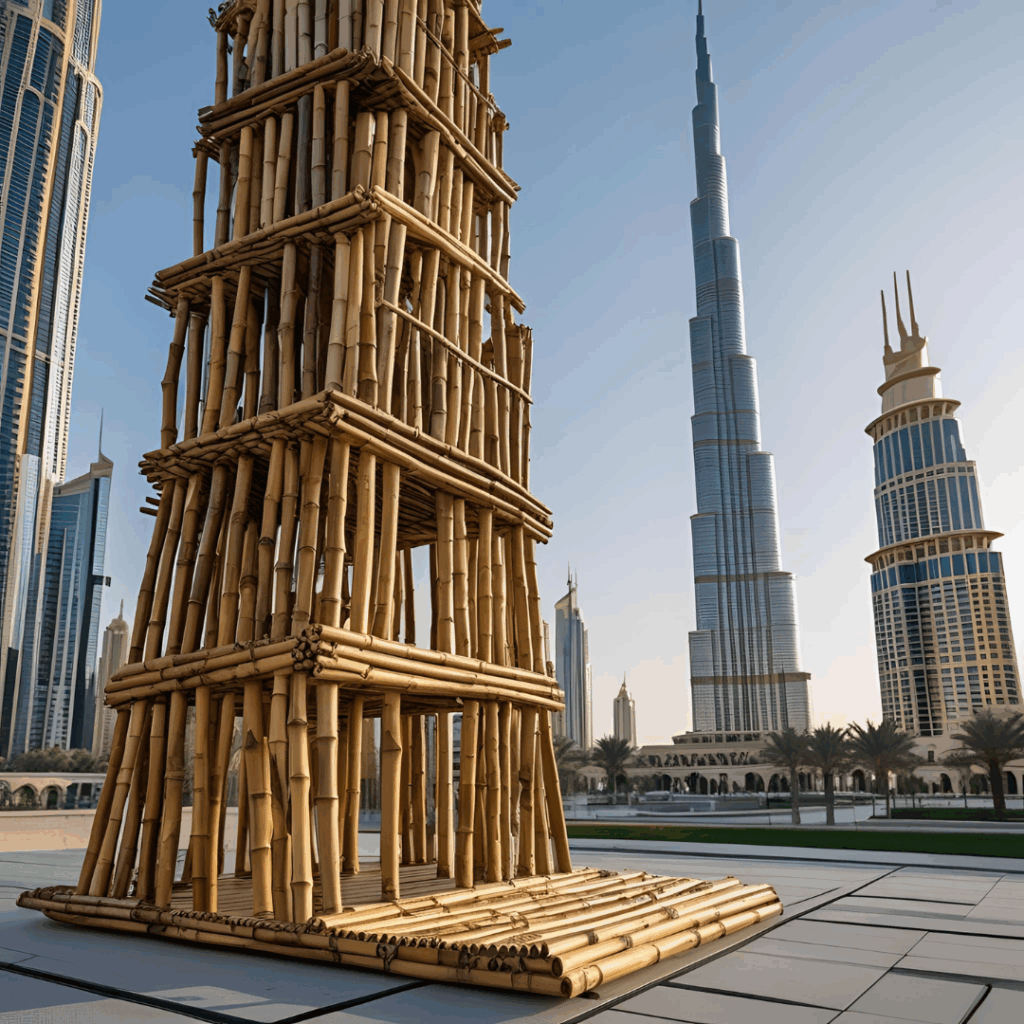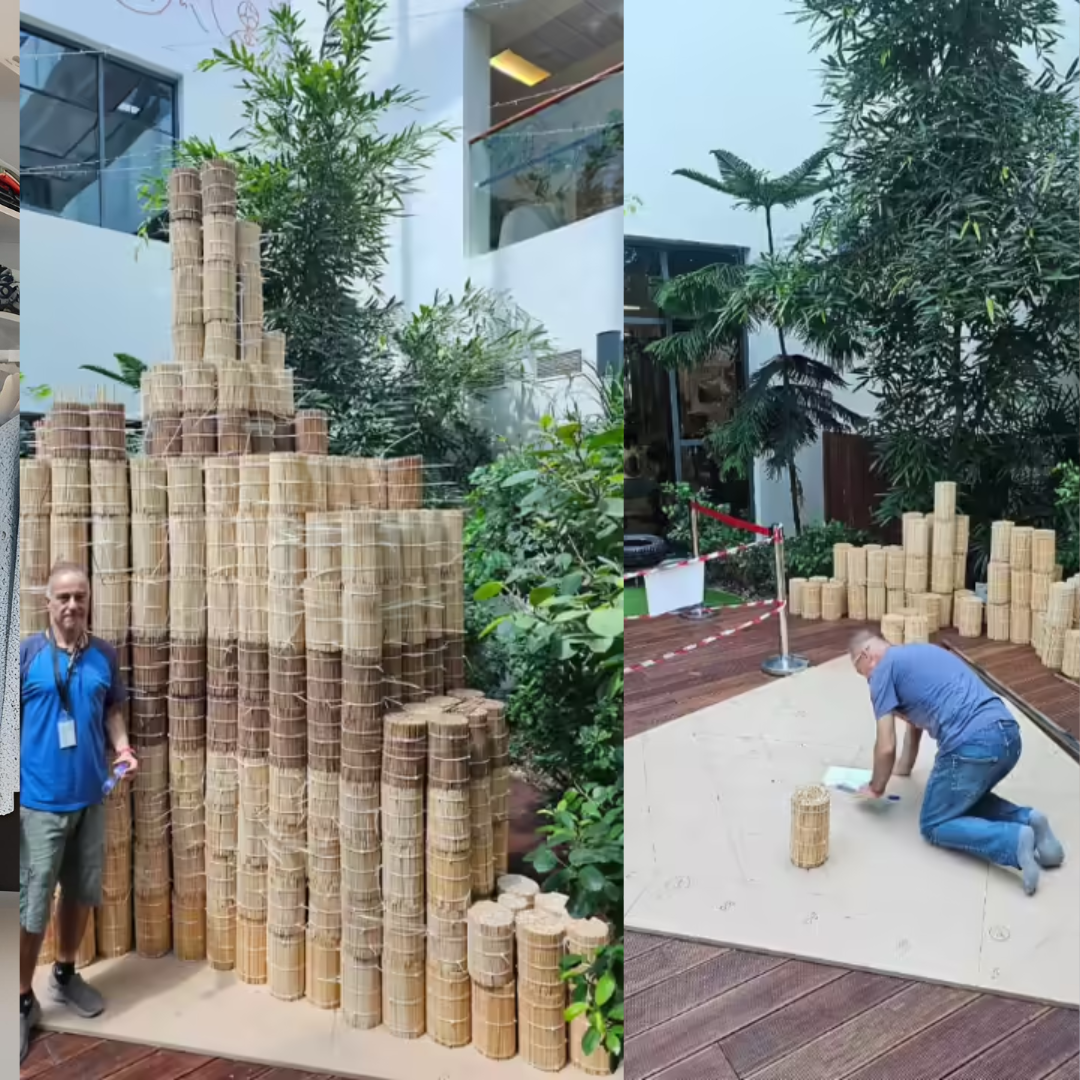In mid-June 2025, Dubai welcomed an incredible piece of sustainable art: a replica of the Burj Khalifa approximately 6 meters tall, built from 2 million recycled bamboo chopsticks. Originally used as eating utensils, these chopsticks were transformed by Lebanese entrepreneur based in Dubai, Charles Jabbour. What began as a school project turned into a symbol of conscious creativity and gained international recognition. More than a miniature monument, the sculpture sparks reflection: how many possibilities can we extract from discarded resources?
2. What is Sustainable Art?
Sustainable art prioritizes reducing environmental impact, creative reuse, and forms of expression that value repurposed materials. These public artworks promote environmental awareness, interact with urban spaces, and engage audiences with narratives of transformation and responsibility.
The Mini Burj Khalifa builds this narrative by elevating a discarded object — the chopstick — into an icon of urban art and sustainable technology in a futuristic metropolis.
3. Similar Artworks Around the World
This sculpture echoes global trends in art that engage with the environment and use waste materials:
- Parque Campana in Brazil, designed by the Campana brothers, features bamboo and stone pavilions promoting ecological awareness linked to childhood and local materials.
- Big Bambú, by Doug and Mike Starn, constructs suspended bamboo labyrinths that visitors walk through at the Met Museum (NY) and other international venues. The installation questions chaos and order in nature and is made from thousands of bamboo poles.
- The Blue Trees, by Konstantin Dimopoulos, temporarily colors trees with non-toxic blue pigment to raise awareness about deforestation.
- Aurora Robson and Thomas Dambo transform discarded plastic and wood into vibrant sculptures — the former with marine shapes, the latter with wooden giants inhabiting natural landscapes.
- El Anatsui from Ghana reinvents bottle caps into monumental metallic tapestries.
- Jean Shin creates waves using melted vinyl records, exposing consumption and popular culture.
All these works share three characteristics:
- Excellent public engagement.
- Sustainable origin of materials.
- A message of ecological awareness that goes beyond aesthetics.
4. Context of the Mini Burj Khalifa
- Author: Charles Jabbour, entrepreneur and educator;
- Material: 2 million discarded bamboo chopsticks;
- Height: 6 m (smaller version than the initially reported 13 m);
- Objective: raise awareness about creative reuse and waste cycles by transforming an everyday object into monumental art.
The piece transformed a simple chopstick into a powerful narrative: from disposable utensil to urban symbol, sparking curiosity, visitation, and reflection.
5. Impact and Lessons for Product Design
5.1. Common Materials as Protagonists
If chopsticks can build a Burj Khalifa, what can you build with “discarded” materials? This idea challenges designers to rethink waste and explore creative uses.
5.2. The Power of Storytelling
“Made with 2 million recycled chopsticks” is a powerful story. Storytelling not only adds value to the work and artist’s brand but also educates, connects, and engages — a competitive and visibility advantage.
5.3. Inspirational Product
The sculpture demonstrates that sustainable products can be extreme, imposing, and sophisticated. The ideal is not less art, but art with purpose.
5.4. Public Engagement and Education
The piece became news, public attraction, and a spokesperson for environmental inclusion. Well-positioned products can spark interest beyond the niche, turning curiosity into understanding.
6. Design and Storytelling Applied to Brands
Below are ways to translate the sculpture’s experience into marketing strategy:
| Step | Application |
|---|---|
| Material selection | Use waste from your supply chain (fabrics, wood, plastic) as creative base |
| Narrative | Tell the origin, process, and impact of the piece — on website, packaging, or social media |
| Aspirational design | Create beautiful, functional pieces with a story |
| Consumer education | Initiatives at digital/physical points of sale about sustainability |
| Public engagement | Exhibitions, events, or free workshops to raise awareness and attract audiences |
7. Public Art as a Branding Tool
In Dubai specifically, a city known for luxury and innovation, the sculpture provokes contrast and reflection — where excess is celebrated, here emerges a structure made of humble, organic chopsticks.
This duality appeals to companies and content platforms (like Google Ads), as it expresses innovation, cause, narrative, and visual appeal — a combination that offers visibility, impact, and high CPC.
8. Emerging Trends in Sustainable Art
Projects like this echo several trends, such as:
- Regenerative design, which goes beyond neutrality to return value to nature;
- Education through art, involving schools and families;
- Organic and renewable materials, like bamboo, plant fibers, and urban waste;
- Circular economy, where the artwork symbolizes meaningful reuse;
- Participatory public art, with shared narratives strengthened in urban spaces.
These trends reflect in the other mentioned works and reveal a growing market for brands that bring purpose (and higher CPMs).
9. What Can You Do Next?
- Map your production waste: what can become creative raw material?
- Prototype and share the process.
- Involve the public: invite schools, communities, visitors.
- Develop a clear, emotional narrative about why each material was chosen.
- Share on media, targeting both end consumers and B2B buyers valuing sustainability.


The Mini Burj Khalifa made of recycled chopsticks in Dubai is a lesson in art, sustainability, and communication. It’s a work that unites technique, aesthetics, and purpose. It educates, mobilizes, and inspires.
For brands and designers, the message is clear:
Creativity + Consciousness = Differentiation.
By turning waste into symbols, you create material and symbolic value. And in today’s digital and commercial landscape — which values content aligned with responsibility and innovation — this movement can translate into credibility, engagement, and relevant performance on platforms like Google Ads.
. Economic and Social Impact of Sustainable Art in Global Cities
Beyond artistic and environmental value, projects like the Mini Burj Khalifa made of recycled chopsticks generate important economic and social impacts, especially in large urban centers like Dubai:
- Boosting sustainable cultural tourism: Innovative artworks attract conscious tourists interested in experiences combining art and sustainability, contributing to the local economy with low environmental impact.
- Creating creative jobs: The development of upcycling and sustainable art projects creates opportunities for artists, artisans, and small entrepreneurs, strengthening the creative economy and diversifying income sources.
- Inspiring public policies: The success of such works can motivate local governments to support sustainable cultural initiatives through tax incentives, grants, and public-private partnerships, fostering a virtuous cycle of innovation and environmental responsibility.
- Community engagement: Projects involving recycling and reuse encourage local community participation, promoting environmental education and a sense of belonging.
In summary, sustainable art transcends aesthetic function and becomes a powerful agent of social and economic transformation — creating a foundation for greener, more innovative, and inclusive cities.
💬 And You?
- Have you ever implemented any artistic or creative project using waste materials?
- What materials do you discard that could be transformed into products or gallery pieces?
- Are you ready to build stories that evoke emotion and awareness?
Comment, share, and inspire other brands to unite craftsmanship, sustainability, and real purpose.







